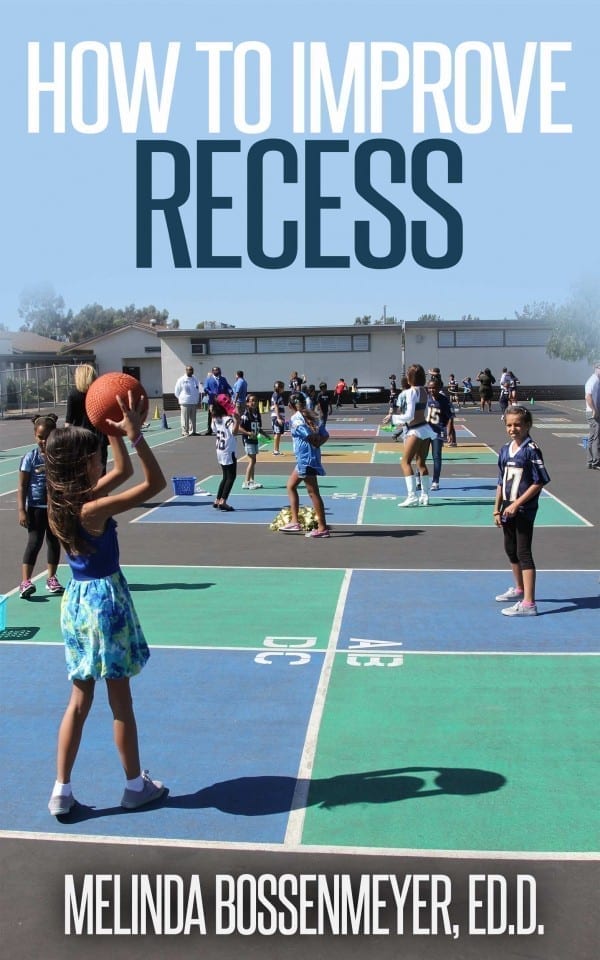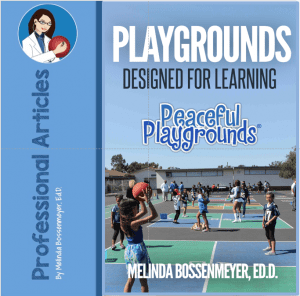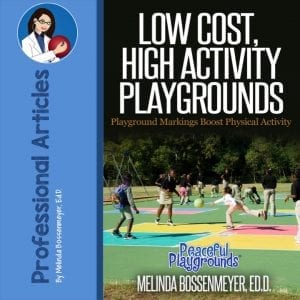Tips for Improving Recess
By Dr. Melinda Bossenmeyer, The Recess Doctor

How to Improve Recess
by Dr. Melinda Bossenmeyer
Last week I wrote an article entitled “School Recess: Why some love and others hate this American Tradition”.
I began the article by citing the school recess movement in Orange County, Florida where there is a growing group of parents who support recess and which gained the attention of CNN, The Today Show and The Ellen Show according to some tweets I received at my @recessdoctor Twitter account.
This week, I promised to write a sequel to the previous article answering the question “How to Improve Recess? ” You see, recess is something I know quite a bit about. As I stated in the previous article, I too was a school administrator who decided to trim back recess in a moment of frustration, primarily based on the discipline issues we were experiencing. However, there is a solution to the discipline issues which many administrators experience.
A big part of restoring recess lies in the need to improve recess and how it functions.
Restoring Recess
A big part of restoring recess lies in the need to improve recess and how it functions. While it is true, there is not much we can do about standing on a cold playground, there is much we can do about the conflicts or boredom which can lead to fights and arguments that spill over into a classroom and impact instructional time.
One of the misnomers about creating an inviting recess is that you need to put in a play structure which can cost upwards of $100,000. When an administrator is contemplating a play structure, they must also understand that surfacing and installation are separate expenses to the purchase of the structure. But play structures, while nice, are not necessary to create an age-appropriate playground for an elementary school.
Five Playground Problems
Peaceful Playgrounds has a “Recess Kit” that holds the solutions to 5 identified playground problems. Namely, inconsistent game rules which lead to arguments, the lack of problem-solving strategies that can be easily and readily taught to students, the lack of equipment (balls, jump rope, etc. ) or tools to be active and establishing behavior rules and expectations for safe play. The real “game changer” was the design of the new game markings. When children were playing peacefully and engaged in games, I created a game marking for the activity. The experience came from my time as teacher, mentor, site principal and regional administrator and seeing first hand what works on playgrounds.
To envision “unique designs”, think of designs like hopscotch and basketball, then think of those designs which include an alphabet grid, alphabet running track, bean bag toss, wall ball, multi-use circle and much, much more. I found that painting the games on the blacktop was the key because it helped children to visually select games and remember “game options”. I found that for children, the “out–of-sight out-of-mind” principle, was in play so a painted marking was the key to ensuring a variety of game options.
Peaceful Playgrounds is only one of many programs which set out to improve recess.
Playworks
Kaelyn blue bars
Another national program is Playworks.
Playworks provides on-site “Play Coaches”, which organize recess for students in low-income and urban schools. Their motto is “We believe in the power of play to bring out the best in every kid”. They create a place for every kid on the playground according to their literature. It does not matter if children have never learned or played games before. Playworks ensures each child has a place that is safe and welcoming – where they can play, thrive and contribute. Playworks’ goal is for every child to take a positive experience back to the classroom and back to their communities. Please see Playworks website for more of its positive information.
Playworks’ research indicates that due to their presence at a school site they reclaim up to 40 instructional hours a year because kids return to the classroom without the drama, compared to these reports of recess problems in previous years.

Related articles on Improving Recess
Improving Recess
When is it Too Cold for Recess?
Why Recess Makes Kids Smarter
10 Reasons Why Recess Is So Important
Five Research Based Playground Problems and Solutions
Five Research Based Playground Problems and Solutions
In review, “how you improve recess” lies in the following 5 principles, according to Peaceful Playgrounds philosophy and goals:
1. Teach all students a consistent set of game rules.
2. Make sure students have enough playground equipment to be actively involved in games.
3. Establish a consistent set of behavioral expectations for the less structured outdoor environment.
4. Train staff and students on the 5 core principles of the program.
5. Add painted games and markings to the playground for active play.
Melinda Bossenmeyer, Ed.D. is an expert witness for school supervision, playground injury cases, physical education, and coaching cases related to supervision. Professional articles by Dr. Bossenmeyer © Peaceful Playgrounds 1998 All Rights Reserved
Related Articles
Playgrounds & Social Skills






